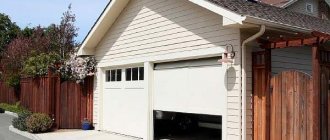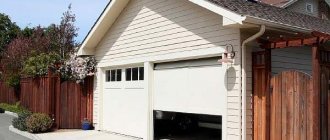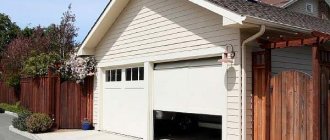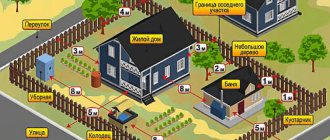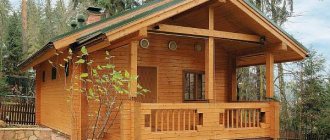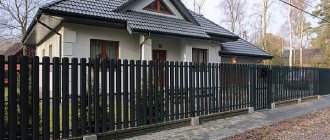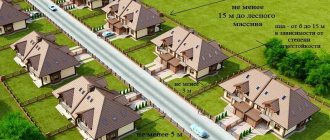Construction of a country house is a complex and multi-stage process. But not everyone pays due attention to the SNiP standards regulating at what distance from the fence a house can be built. They also often forget about the standard distances between the fence and other household objects (garage, shed, bathhouse, etc.). Or they believe that the value of this distance can be absolutely any.
At the construction planning stage, it is necessary to take into account all norms
But this issue only seems insignificant. The distance between the house and the fence is determined by most factors, which should not be neglected. Therefore, at the stage of developing a site development plan, it is necessary to focus not on the approximate distance from the fence, but be guided by the relevant regulatory documents.
Features of the site layout
The distance from the fence to the future home is only one determinant of many civil engineering standards. The distance is indicated in SNiP. To plan a site, it is necessary to disclose as much information as possible at what distance from the fence a house can be built. It will help land owners independently draw up a development plan and obtain permission to build a house.
To create a plan you will need:
- SNiP 30-02-97 (building codes and regulations). They describe the standards that must be observed during construction.
- SP 11-106-97 (set of rules). It contains the necessary materials for the development of design and planning documentation and its approval by government authorities in accordance with current legislation.
SNiP 30-02-97 contains recommendations on the basis of which the optimal location of buildings on a suburban area is calculated. He also tells you at what distance from the fence you can build a house. According to current fire and sanitary standards, it is prohibited to build neighboring houses and facilities for household needs next to each other.
This does not depend on how accurately the distance between the fence and objects is maintained. Such recommendations are dictated, among other things, by fire safety rules, since if any object catches fire, the flames from it can spread to buildings located nearby.
The fence is installed according to all the rules
Current fire regulations establish the following distances between residential neighboring buildings on the site:
- 6 m – distance between stone, concrete, brick buildings;
- 8 m is the minimum distance between buildings, the structure of which includes wooden beams and ceilings;
- 10 m from any other than wooden building;
- from 15 m between any wooden houses in SNT and individual housing construction.
Landing rate
When calculating the distance from a neighbor's fence to a tree, the axis of the plant (the middle) is taken as the reference point. The crown and roots are not taken into account because the established distance is necessary precisely so that branches and roots do not interfere with neighbors and do not destroy buildings and communications.
Therefore, the law establishes different distances from adjacent fences for different types of plants:
- tall trees - 4 m;
- medium trees – 2 m;
- shrubs – 1 m.
Tall trees include plants that can reach a height of more than 15 m. These are birch, poplar, spruce, cedar, pine, large apple trees, nuts, and pears.
Medium trees include plants that do not exceed 10 m. These are figs, almonds, oranges, peach, bird cherry, serviceberry, apricot, plum.
Shrubs, in addition to directly tall and low shrubs, also include climbing and creeping plants, and dwarf tree species.
Distance between buildings and fence
Sanitary rules establish the distance between the buildings being erected and their minimum distance to the fence on the site. It is worth noting that most of these recommendations and standards are not always implemented in practice. Their implementation is rarely monitored. However, you should not neglect them. When changing the form of ownership, re-registration or sale of home ownership, certain problems may arise because of this.
In accordance with SNiP, the reference point for the distance between the house and buildings on the site is the outer wall of the residential building.
The distance between neighboring houses is also measured from it. According to sanitary rules, the latrine must be placed 12 m from a residential building. In this case, the minimum distance from the toilet to the fence should be 1 meter. An outdoor shower or bathhouse must be located at least 8 m from the house. In addition, the distance from the well to the toilet or cesspool must be at least 25 m. This will completely eliminate the risk of sewage getting into drinking water.
According to SNiP, a well with artesian drinking water (well) can be placed in any convenient location on the site. However, you should not neglect the recommendations regarding the arrangement of a toilet, cesspool and compost pits. At the stage of developing a site development plan, it is necessary to apply current standards not only to them, but also to take into account the layout of neighboring ones.
In other words, if the distance from the fence to the bathhouse is 5 m, then at a distance of 7 m from the fence you can build a residential building on an adjacent plot. The distance can and should be calculated in a straight line before construction begins in accordance with SNiP standards and the law.
Compost heaps are often located near the greenhouse, so it is not advisable to place a well near it. Whatever the limited space of your summer cottage during construction, it is recommended to place them at the maximum distance from each other. In addition, it is not recommended to take the artesian well outside the fence.
Important to consider
In case disputes arise between neighbors regarding planted trees, shrubs and other vegetation, it is necessary to contact the local government in writing. It must indicate in detail the essence of the problem, be sure to include a date and signature.
The review will take several days (up to 10 days). After this, the authorities are obliged to go to the site and help the neighbors sort out the issues of the incorrectly planted plant. Please note that three days after the application, both parties to the conflict must receive a response in writing about the decision made. Also, each neighbor should be informed about the day the authorities will go to the site to solve the problem, and wait.
The outcome of the decision can be positive or negative. If the parties do not agree with the decision made, they have the right to go to court to re-decide the issue. Please note that local authorities have the right to ask to cut down a tree or dig up interfering bushes.
Optimal distance to the fence
It consists of a number of factors. This is dictated by the fact that buildings located in close proximity to the boundaries of households do not always have a beneficial effect on the territory of neighboring plots. In accordance with this, the following procedure for placing buildings on the site relative to the fence is established:
- from the fence to the house the minimum distance should be at least 3 meters;
- the distance from the fence to the building can be changed up or down by mutual decision of the neighbors. This must be documented;
- the distance between the utility block and the fence depends solely on the purpose of the building (barn, bathhouse, bathroom, veranda, summer kitchen, etc.);
- the distance from the greenhouse to the fence must be at least 1 m;
- a garage can be built 1 meter from the fence on the garden plot;
- sanitary buildings must be located at a distance of at least 1 m from the fence between neighboring areas;
- if the bathhouse has a separate drainage system, then the distance between it and the fence can be reduced from 3 to 2.5 m.
Compliance with these standards will not cause any particular difficulties. If the site is being developed by a contractor, all buildings must be erected in accordance with the stated requirements. When independently constructing and improving the territory, it is necessary to familiarize yourself with all regulatory documents. It is necessary to adhere to the recommendations contained in them in order to avoid possible problems and conflict situations in the future.
Standards for garden plots
Types of discomfort that improperly planted houses can cause
Planted trees should bring joy to you, as the owner of the local area, but not cause discomfort to your neighbor. The problem may appear in a number of cases:
- the crown of the tree obscures light-loving crops in the neighboring area (thereby affecting the yield of a particular crop);
- the branches of your plant may litter the neighboring area with falling leaves;
- the greater power of the root system prevents neighboring plants from feeding and bearing fruit normally.
If such problems regularly arise, the neighbor has the right to independently cut off the interfering branches (even if there are fruits on them) or contact the administration (village council) to resolve the issue through legislative regulation.
Recommendations for the construction and placement of enclosing structures
The standards that regulate the height of the fence and its location on the site are purely advisory in nature. But you should still adhere to them in order to avoid possible conflicts and quarrels with neighbors in the future.
No matter what kind of fence you want to put between adjacent areas, it is still better not to violate the requirements. So, a fence with a maximum height of no more than 1.5 m should be placed on the border of the plots. Also, a blind fence cannot be erected so as not to shade the adjacent plot. Therefore, for erected fences, it is undesirable to use solid sections made of boards, corrugated boards, stone and bricks.
The best choice would be a welded or chain-link fence.
If the fence located on the side of the road exceeds the height of 2 m, approval for its installation will be required from the local architectural department. Fences located opposite highways and highways are also subject to approval, since they have to be built above the required standards for additional noise insulation.
Standard distance between buildings and fences
Common types of fencing
The fence serves not only to define the boundaries of a home. It also performs a protective function, preventing unauthorized persons from entering. Therefore, special attention should be paid to the design and material from which the enclosing elements will be made.
Additional precautions
In the case of planting tall trees near the fence, it is necessary to discuss this issue with the neighbors. The owners of the second plot must sign a notarial agreement to issue consent for planting. This document will be valid even if the owners of the site change.
After the tree grows, the owner of the plot must take care that it does not throw needles or foliage onto the neighbor’s plot. If large branches hang over the neighboring area, then they must be removed.
Reviews of conflict situations regarding green spaces
To make the situation clear, we suggest that you read reviews from real people who have encountered similar problems.
Marina, 46 years old, Voronezh
They say that ignorance of the law does not exempt you from responsibility. Unknowingly, I planted a tree right next to the neighbor’s fence. When the plant grew, it began to tear apart the fence mesh. The neighbor went to court without waiting for a decision from local authorities, without asking me. I won the case and a fine was collected from me.
Mikhail, 54 years old, Shchelkino
All our lives we lived amicably with our neighbors until they planted fruit trees right next to the fence - 40-50 cm from it. On my side of the plot there were strawberries growing, which began to die due to lack of sunlight. Local authorities forced neighbors to compensate for the damage and replant fruit crops.
Valentina, 49 years old, Pushkino
I bought a plot of land in a holiday village and planted trees, not knowing that there was a water supply running underground. 7 years later, the apricot roots violated its integrity, and there was a breakthrough. After that, I was forced to pay a fine and repair communications at my own expense.
Generalized table
In order to plan planting, you can refer to the table reflecting the current law.
| An object | Distance (m) | |
| Up to the trees | To the bushes | |
| External walls of buildings | 5 | 1,5 |
| Base of retaining walls | 3 | 1 |
| Ditches and ditches | 2 | 1 |
| Paths | 0,7–1,5 | 0,5–0,7 |
| Fences and enclosures | 4, and in SNT – 3 | 1 |
| Highway | 2 | 1 |
| Power lines | 1,5–2 | – |
| Gas pipeline, sewerage | 1,5 | – |
| Water supply, heating networks | 2 | 1 |
| Power cable, communication | 2 | 0,7 |
Do you need to follow the rules?
The norms of SP, SNiP and SanPiN were not invented so as to ensure that they are observed. For neglect of instructions, administrative liability is provided, which is regulated by Art. 9.4 of the Administrative Code of the Russian Federation. The first time the offender will receive a verbal warning. If it is not eliminated, a fine of 1 to 2 thousand rubles will be issued.
More serious sanctions will follow if it is proven that disregard for the rules has caused harm to nature or neighbors. The first time the offender faces a doubled fine, that is, from 2 to 4 thousand rubles. Repeated violation is punishable by an even larger fine of up to 5 thousand rubles. Litigation over non-compliance with the distance to the fence is not uncommon.
It is noteworthy that establishing the fact of non-compliance with the minimum distance between a house, building or tree and a fence is not yet a reason to force the violator to solve the problem. Demolition, relocation of a building or removal of green spaces can only be achieved through the courts. However, the best option is to maintain a distance from the house to the fence and avoid conflicts.
